The GeForce GTX 770 Roundup: EVGA, Gigabyte, and MSI Compared
by Ryan Smith on October 4, 2013 9:00 AM ESTPower, Temperature, & Noise
Having seen the gaming performance of these cards and the limited gains from their factory overclocks, let’s move on to power, temperature, and noise. If these cards are going to differentiate themselves it needs to be accomplished by factors the manufacturers have more control over, and their respective coolers are a good way to do it.
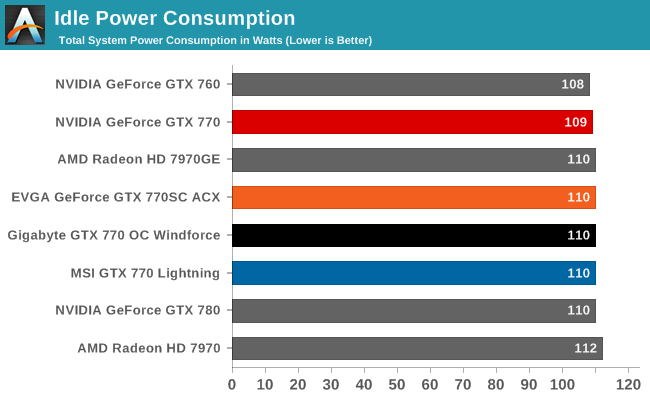
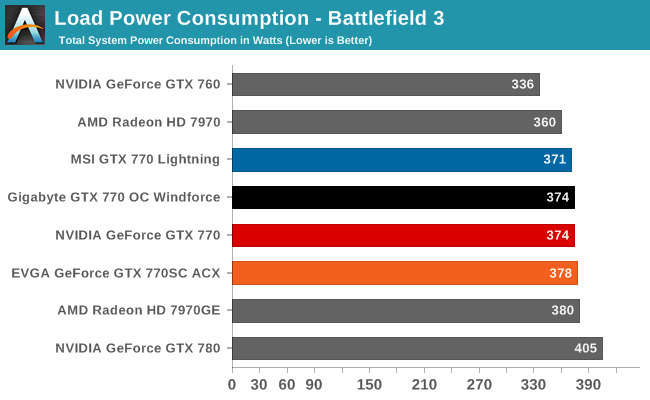
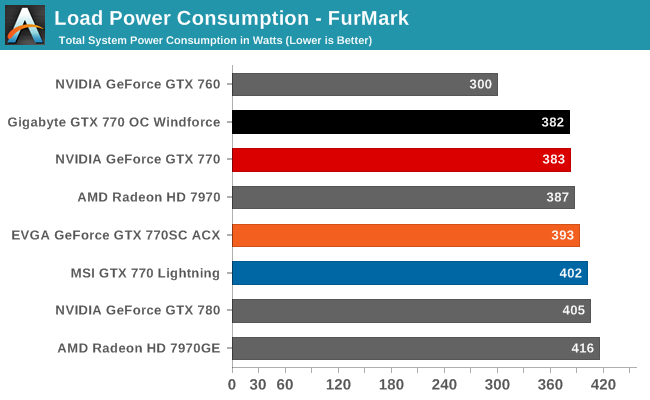
With our cards spanning the full spread of possibilities – semi-custom, custom, and custom with heavily modified power delivery – even load power consumption starts separating the cards to at least a small degree. Although it’s just a minor difference, MSI’s GTX 770 Lightning has the lowest power consumption of the three in Battlefield 3, beating every GTX 770, including the lower clocked stock GTX 770, by at least a few watts. Since we are memory bandwidth limited in BF3, and thereby performance limited, for better or worse these cards can’t get too far from each other. But for a few watts difference we’re in all likelihood looking at general chip-to-chip variation rather than some intrinsic advantage in any one card, even with the use of custom components.
FurMark on the other hand shows some larger differences, but as this is our stress test what we’re really seeing is the difference in the cards’ regulated TDP. MSI’s 260W TDP means they have a larger power budget to work with, draw more power, and don’t get throttled quite as hard as the other cards. The end result being that FurMark is not particularly useful in comparing cards in this case. Otherwise the difference between the EVGA and Gigabyte cards is larger than we’d expect even with chip to chip variation, which may mean Gigabyte’s Ultra Durable component selection has some impact under maximal workloads.
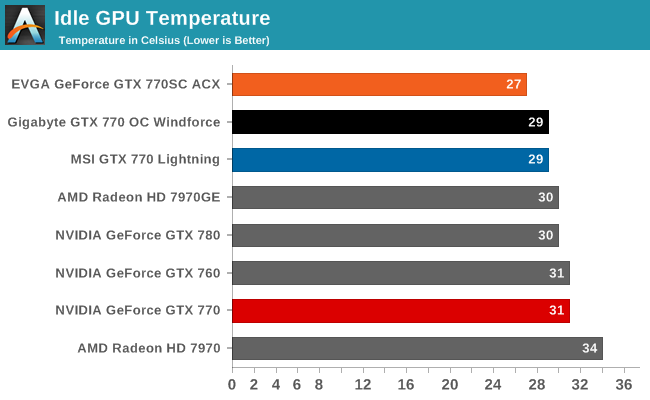
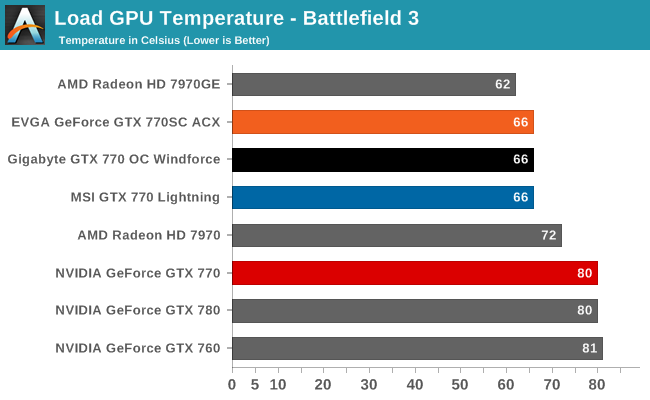
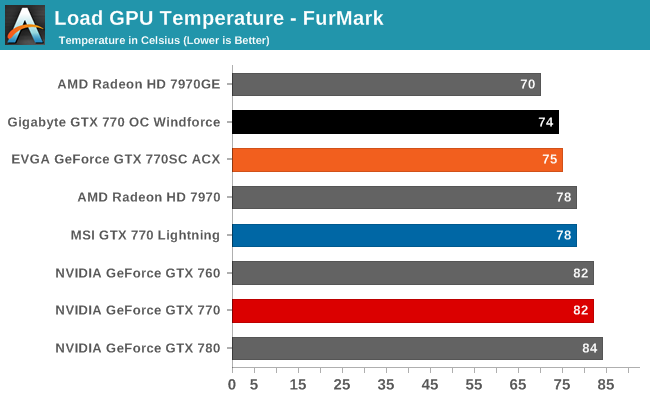
Moving on to temperatures, despite the difference in both the number of fans and the size of said fans, the end result has all of our cards perfectly tied under BF3. Every card tops out at 66C, EVGA, MSI, and Gigabyte alike. Open air coolers as a general design are difficult to improve on, so despite everyone’s efforts, unless someone uses a wildly different fan curve than the others then any well designed open air cooler should perform similar. Notably, because every card tops out at 66C, they’re all well below the thermal throttle point on the GTX 770 of 80C. This means no card ever throttles, which can be useful for squeezing out a little more performance out of what’s otherwise the same GPU.
Meanwhile FurMark temperatures are less than useful here for the same reasons as power. Gigabyte and EVGA top out at 74C and 75C here respectively, while the higher TDP MSI card tops out at 78C. Though this does go to show that even in our stress test none of these cards reaches the 80C throttle point.
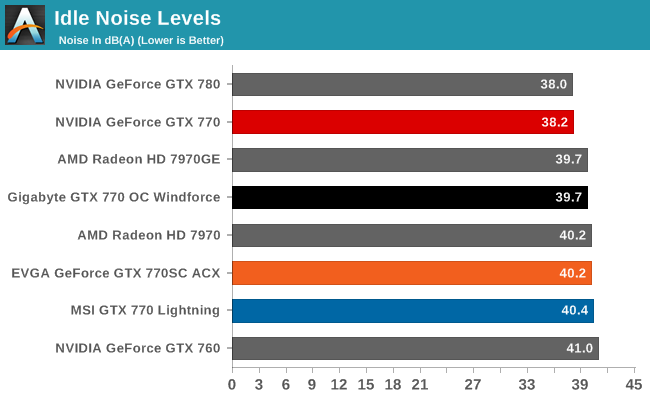
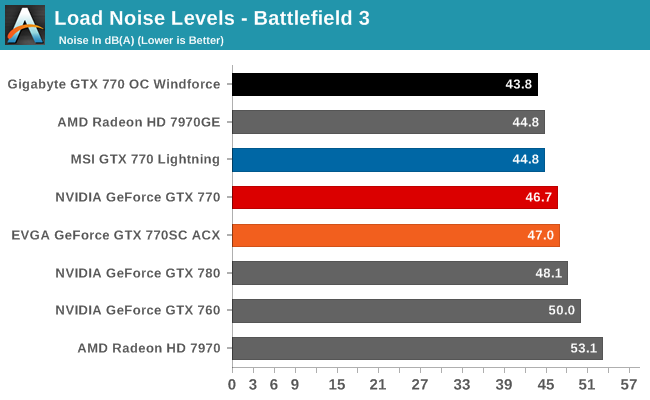

Finally looking at our noise results, we find that unlike our performance data there’s some clear and meaningful separation between the cards, especially between the EVGA card and the remaining two cards. For whatever reason the EVGA card hits 47dB under BF3, a hair louder than even the blower based reference GTX 770. Admittedly the Titan cooler on the reference GTX 770 is overbuilt for a card of this configuration, and as such over performs and is by no means easy to catch, but it does mean that EVGA isn’t gaining anything over the blower from a noise perspective. It’s no worse, it’s just not any better, which indicates that EVGA’s ACX cooler may not be scaling down very well.
MSI and Gigabyte on the other hand manage to beat EVGA and the reference GTX 770 by 2-3dB, a small but not insignificant amount. The winner here is Gigabyte at 43.8dB under BF3, followed by MSI at 44.8dB. These noise levels aren’t going to be silent, but they’re also not too far off of it. For the level of performance these cards offer it’s a fairly impressive outcome, albeit the typical one for the open air cooler tradeoff.
Speaking of silence, when it comes to idle noise every card is actually a bit worse than the reference GTX 770 here, owing to NVIDIA’s single fan and use of materials. The roughly 40dB results aren’t by any means bad, but they aren’t going to get as close to being silent as NVIDIA’s reference blower.
In summary, differences in TDP aside all three cards are solid, similar performers when it comes to temperature and power consumption. However when it comes to noise under load, both Gigabyte and MSI have an edge here over EVGA and the reference GTX 770, which for stock performance does give these cards a small but meaningful lead over the competition. Gigabyte is the best performer in this respect, although MSI is right behind them. At the same time however this means that despite the difference in the designs of their coolers – 3 smaller and 2 larger fans respectively – it isn’t creating a practical difference between the Gigabyte and MSI cards.










55 Comments
View All Comments
Ryan Smith - Friday, October 4, 2013 - link
We're not setup to review open loop coolers. However the new testbed will be able to accommodate GPUs with closed loop coolers, such as the Asus Ares.Hrel - Friday, October 4, 2013 - link
I am just endlessly impressed with Gigabyte. The consistently offer a performance to value ratio that is either the best or among the best and they do so at very competitive prices even without discounts and sales. When their products do go on sale they're simply unbeatable. I can't wait to see them expand into more categories.Hrel - Friday, October 4, 2013 - link
Also, their reliability is flawless and their support is top notch.Anandtech, when are you going to update your comment section? We REALLY need more features. The ability to edit comments, notifications via email when people respond. These are BASIC things.
Edkiefer - Friday, October 4, 2013 - link
This is one time for MSI, it probably just pays to get MSI Gaming N770 TF 2GD5/OC model as you mention 770 are pushed to limit already . The MSI gaming N770 TF is same price as others 399$RadiclDreamer - Friday, October 4, 2013 - link
I've been waiting for some time for a review that includes the 4GB version as well, any chance of that happening?Kevin G - Friday, October 4, 2013 - link
8.2 Ghz is very impressive for a memory overclock. I'd love to see such speeds on Ttian or the R9 290x for the extra bandwidth. That'd get you 524 GB/s bandwidth on the R9 290x which should be very beneficial for 4k gaming. Of course this is wishful thinking as going with a wider bus often limits memory bus speeds, but one can dream right?The Von Matrices - Saturday, October 5, 2013 - link
The problem is that the wider you make the memory bus the harder it is to route the traces on the PCB to allow high-frequency operation. AMD is only shipping the R9 290X at around 5GHz memory, and you can bet that in order to save on costs they won't be using higher rated memory chips. It might take custom PCBs before different memory chips are used, and AMD isn't allowing vendors to customize the card at all at launch.hulu - Friday, October 4, 2013 - link
You can use MSI Afterburner on any AMD/NVidia based graphics card regardless of vendor. Only thing you lose by going non-MSI non-reference board (like the Gigabyte of this roundup), is voltage control, but that is limited on these GTX 700 series cards anyway.wsaenotsock - Friday, October 4, 2013 - link
Maybe I missed it, but where the hell is the test system's information, or did including that information go out of style..iTzSnypah - Friday, October 4, 2013 - link
I think that to truly test the effectiveness of each cooler the noise and temperature graphs should use the reference clocks.